Do you know how to choose a right memory card for camera? If not, you can read this post, in which MiniTool tells you the main points of purchase and lists some high-performance camera memory cards.
How to Choose a Memory Card for Camera?
When you have bought a camera, you basically need to buy a memory card for it, because some cameras do not come with memory cards, or the memory cards’ capacity is too small to meet user’s needs. In this case, you need to know how to choose a memory card for your camera.
What Type of Memory Card Is Required?
We are aware that there are many types of memory cards. If you buy a wrong memory card for camera, your camera will not accept or recognize the card. For novice users, you need to know what type of memory card you need for your camera.
To check what memory card a camera supports, you can find that in the “Technical Specifications / Specification Parameters” section of the official product introduction page. If you can’t find it, you can also ask the official website customer service.
At present, the mainstream camera memory cards include micro SD (TF) cards, SD/SDHC/SDXC cards, CF/CFast/CFexpress cards, XQD cards, etc. These memory cards look like the following picture:

The differences between these memory cards are as follows:
- The smallest TF card is only the size of a fingernail and is more used in small digital cameras, sports cameras, drones, panoramic cameras, driving recorders, and other small devices. In addition, putting the TF card into a card adapter, you can use it as an SD card. Neither capacity nor speed is affected, but reliability will be worse.
- SD cards have 4 types: SD that has up to 2GB capacity, SDHC that has 2 to 32 GB capacity, SDXC that has 32GB to 2TB capacity, and SDUC that has 2 to 128TB capacity. Ordinary SD cards (up to 2GB) have gradually withdrawn from the market. But SDHC/SDXC cards are still widely used in mirrorless cameras, compact cameras, and low-end SLR cameras.
- SD devices only support SD cards; SDHC devices support SD cards and SDHC cards; SDXC devices support SD cards, SDHC cards, and SDXC cards. You may find that SDXC cards can’t be used in SD/SDHC devices and SDHC cards can’t be used in SD devices. That’s because the file systems these cards use are different. Finally, there is no SDUC product on market so far.
- SD cards are currently the most common and popular memory cards. Only a few high-end cameras do not support them. According to incomplete statistics, cameras that do not support SD cards include: Canon 1D X Mark III, 1D X Mark II; Nikon D5, Z6, Z7; etc.
- CF cards, CFast cards, and CFexpress cards are different and they are incompatible with each other, although their specifications are made by the same institution—CFA (CompactFlash Association).
- CF cards and CFast cards are sure to be phased out due to outdated technology. The CFexpress card appeared in 2017, and it is not yet popular enough now, but it has a relatively good development prospect. It’s currently used by a few high-end cameras.
- XQD card specification was released in 2011, but it was soon surpassed by the CFexpress card. Therefore, it’s very possible that the XQD card will be eliminated from the market in the future.
- The CFexpress card features three formats: type A, type B, and type C. At present, the most common type is CFexpress type B, which has exactly the same size and appearance as XQD cards. In addition, the XQD slot can accept CFexpress cards (which may require firmware upgrades), but the CFexpress slot cannot accept XQD cards.
Some cameras are equipped with two different slots. You can choose the best slot and buy a right camera memory card for it.
How Much Capacity Is Required?
For most people, a 32GB or 64GB memory card should be just fine. A midsized card should be able to capture hundreds, even thousands of photos, and scores of video clips. But if you want to shoot RAW files with an SLR or mirrorless camera, you’ll either need to buy a larger card or several smaller ones and be ready to swap them as they fill up.
Besides, if you want to shoot a video, this may consume more capacity and the actual hours of video the memory card can hold is also affected by resolution. For example, you can capture 80 minutes of HD video on a 32GB card, but that same card can hold roughly a quarter of that—about 20 minutes—if you shoot 4K (or ultra HD resolution) video.
Therefore, you should choose a large-capacity memory card. 64GB and 128GB memory cards are recommended. If you have a business task and need to shoot a lot of videos, 256GB is also OK.
The Need for Speed
Memory card speeds include reading speed and writing speed. The reading speed affects the speed at which you use your computer or camera to review the files stored in the card; the writing speed affects the speed at which you take pictures and the quality of videos.
The memory card write and read speed will have the following effects on taking pictures and shooting videos:
- A card with high write speed will allow the camera to shoot more pictures continuously, while a card with low write speed will make the camera that does continuous shooting stuck.
- High write speed cards make cameras to wait a shorter time after it shoots continuously, while low write speed cards make cameras wait a longer time.
- A high write speed card can withstand video shooting at high data rate (it is also called bit rate; in general the higher the bit rate, the better the picture quality), while a low write speed card is not allowed to shoot such a video or it will cause the video shooting process to stop suddenly.
- High read speed cards take less time to export photos to computers and other devices, while low read speed cards take longer to export photos.
In the past, people seldom paid attention to the write speed, because at that time, ordinary photography enthusiasts had low requirements for continuous shooting and did not have the habit of shooting video.
But now with the rise of short videos and Vlogs, more and more people have become video creators, and they have to emphasize the write speed that will affect the continuous shooting and video recording experience.
Then, how to check the read speed and write speed of a memory card? Please follow the tips below:
1. Find the read and write speeds marked by manufacturers
Some memory cards will mark read speed and write speed separately, while some memory cards only mark the read speed. If possible, you should find these read and write speeds for reference.
2. Check speed class if it’s an SD memory card
If you plan to buy an SD memory card or a micro SD card for camera, you should check the speed class. The SD card speed class can be divided into 3 types: ordinary Speed Class, UHS Speed Class, and Video Speed Class. The speed class stands for the actual minimum sequential write speed, which is important in video shooting.
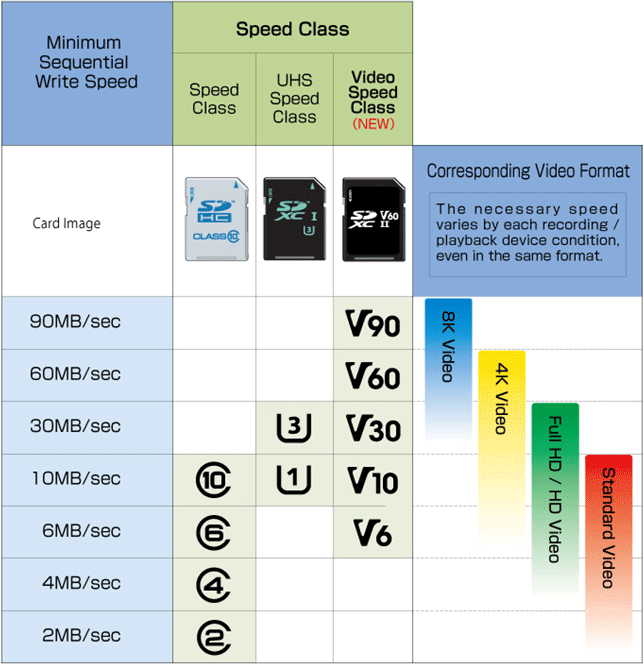
The above picture shows the specific speed that each speed class stands for and what video format can be recorded by SD cards of each speed class.
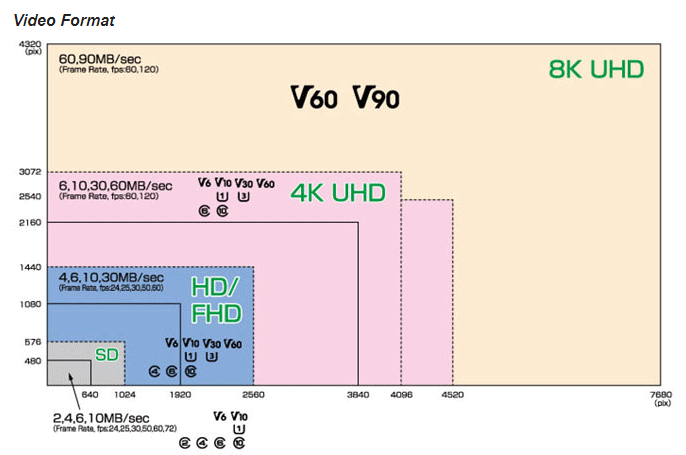
This picture shows the relationship between video format and resolution. You can learn what video format can be recorded by SD cards of each speed class visually. According the speed class, you can find the right camera SD card.
In general, an SD card whose speed class is no more than C4 can’t be used to shoot an HD/FHD video; an SD card whose speed class is no more than C6 can’t be used to shoot a 4K UHD video; an SD card whose speed class is not V60 or V90 can’t be used to shoot an 8K video. But in most cases, you need a C10 camera SD card at least and a U3 SD card is better.
If you plan to buy a CF/CFast/CFexpress card, there are also 3 speed class systems for it. The first is the “x” rating, for example, 400x, 600x, 800x, 1000x and 1066x levels, wherein x stands for 150KB/s and 400x is 150 * 400 = 60MB/s.
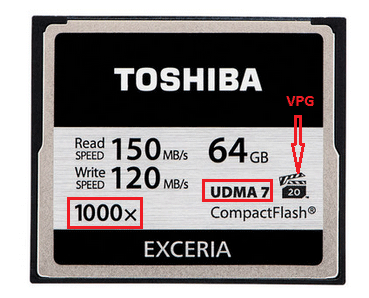
The second rating system is UDMA mode. This is a data transfer mode, with which transfer speed can be improved, for example:
- UDMA 4 (CF 3.0): Up to 66MB/s (The UDMA mode starts from CF 3.0).
- UDMA 5 (CF 4.0): Up to 100MB/s.
- UDMA 6 (CF 4.1): Up to 133MB/s.
- UDMA 6 (CF 5.0): Up to 133MB/s.
- UDMA 7 (CF 6.0): Up to 167MB/s.
The last rating system is VPG (Video Performance Guarantee). It starts from CF 5.0 and is designed for very high-end HD video recording (professional DSLR cameras and camcorders). It is a minimum speed guarantee for the application to continue writing the data stream.
Usually, VPG 20 means that the minimum continuous recording speed is 20MB/S. VPG 65 means that the minimum continuous recording speed is 65MB/s.
3. Check bus interface speed standards if it’s an SD memory card
The bus interface is the technology used when making SD cards, including High Speed, UHS-I, UHS-II, etc. The bus interface used in SD card determines its speed limit. For example, UHS-I SD cards’ speed will never exceed 104 MB/s.

Best Camera Memory Cards
In this part, I will list some best SD cards series, best micro SD card series, and best CFexpress series for you:
1. Sony TOUGH-G series SDXC UHS-II Card
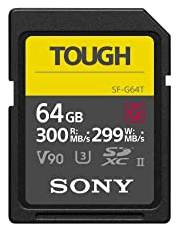
2. SanDisk Extreme PRO SDXC UHS-I Card
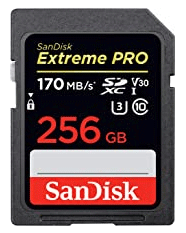
3. Lexar Professional 1800X MicroSDXC Uhs-II Card
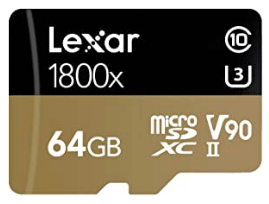
4. SanDisk Extreme MicroSDXC UHS-I Memory Card
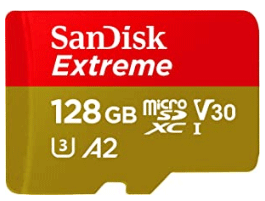
5. SONY Cfexpress Tough Memory Card
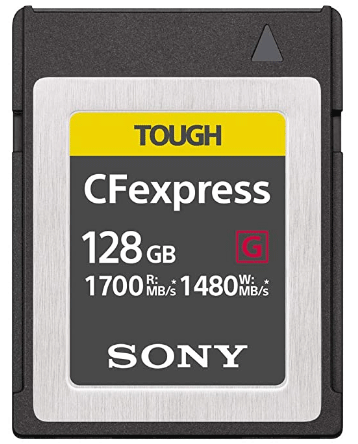
Camera Memory Card Format
Sometimes, you need to format camera memory card. Here are two example cases in which you should consider formatting the camera memory cards:
Case 1: You encountered various camera memory card errors, for example, your memory card is not recognized by your camera, or something like that. In this case, you need to repair the memory card by formatting it.
Case 2: You want to insert an SDXC card into an SDHC camera. In general, you can’t insert SDXC cards into SDHC cameras because SDHC devices support FAT32 file system while SDXC cards use exFAT file system. But this problem can be solved by changing the file system.
When you change the file system from exFAT to FAT32, there is a problem that only partitions within 32GB can be formatted to FAT32. That means that formatting the SDXC card to FAT32 will fail definitely. In this case, you need a tool like MiniTool Partition Wizard, which allows you to format a partition beyond 32GB to FAT32 file system.
No matter which case you are in, you can use MiniTool Partition Wizard to solve the problem. Here is the guide on how to format camera SD card with MiniTool Partition Wizard:
MiniTool Partition Wizard FreeClick to Download100%Clean & Safe
Step 1: Connect your camera memory card to a computer via a card reader. Then, click the above button to free download MiniTool Partition Wizard.
Step 2: Launch MiniTool Partition Wizard and go to its main interface. Right-click the partition on the SD card and choose Format.

Step 3: Choose a file system from the list and then click OK button. From the list, you can choose FAT32, exFAT, NTFS, etc.
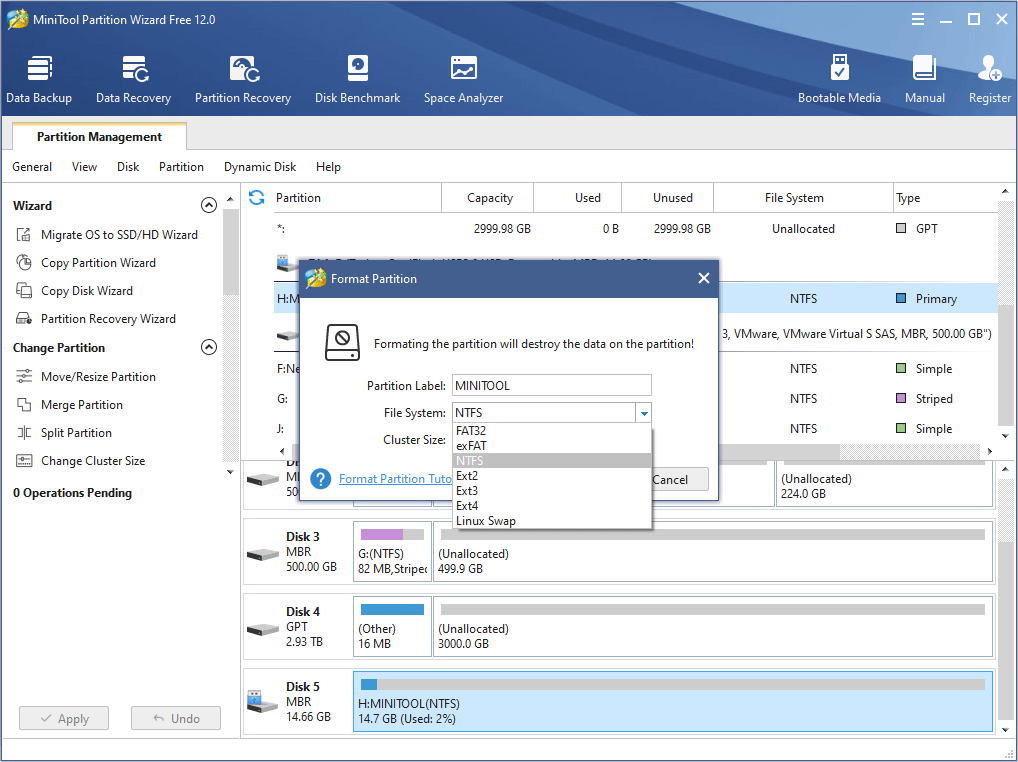
Step 4: Click Apply button to execute the operation. Then, your SD card will be formatted to the new file system.
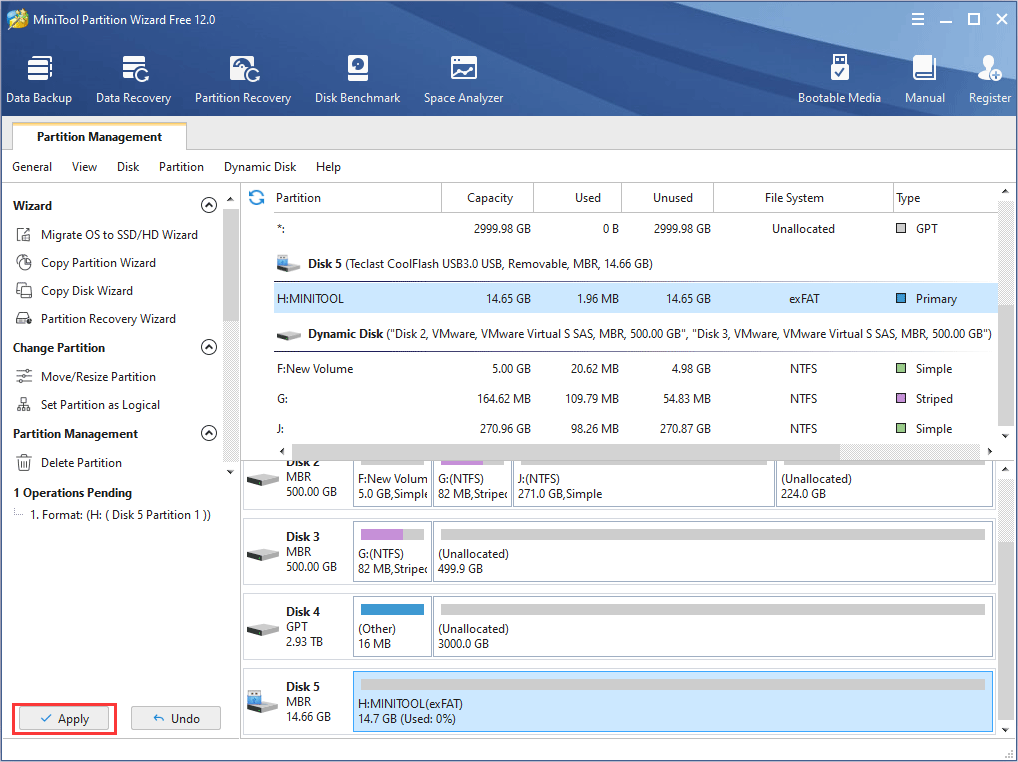
Bottom Line
Is this article helpful? Do you have questions about this post? Please give us your feedback. Besides, if you have difficulty in formatting memory card, please leave a comment below or contact us via [email protected]. We give you a reply as soon as possible.
Camera Memory Card FAQ
- Sony TOUGH-G series SDXC UHS-II Card
- SanDisk Extreme PRO SDXC UHS-I Card
- Lexar Professional 1800X MicroSDXC Uhs-II Card
- SanDisk Extreme MicroSDXC UHS-I Memory Card
- SONY Cfexpress Tough Memory Card
Please choose a proper camera memory card according to the form factor, bus interface, capacity, etc.


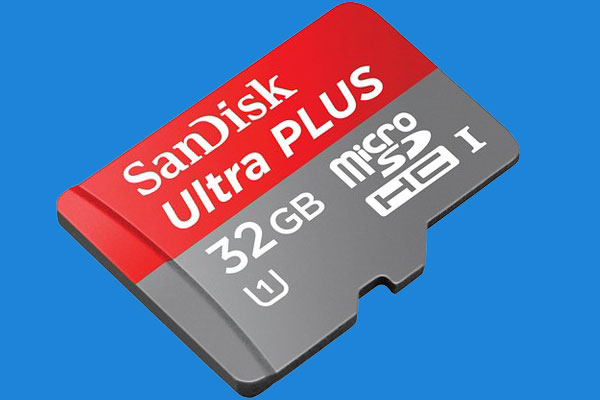
User Comments :